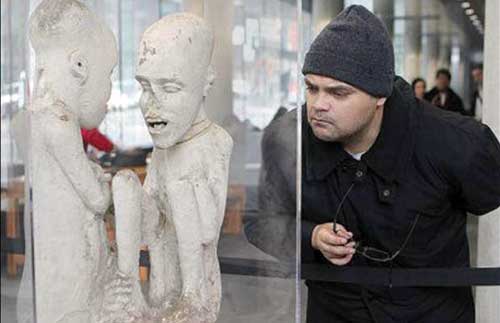
 Sculpture News at SculptSite.com
Sculpture News at SculptSite.com
Concordia University's Mysterious Limestone Sculpture |
| montrealgazette.com BY PEGGY CURRAN, THE GAZETTE Experts can't crack Concordia sculpture riddleThere's more to the ancient stone - and honestly, kind of ugly - sculpture perched in the atrium of Concordia's engineering and visual arts building than meets the eye. But what is it? A rare Egyptian artifact dating from a time before the Pharoahs, or an elaborate fake? Even Clarence Epstein doesn't know, and he's spent more than a decade puzzling over the limestone piece, titled The Starving of Saqqara, which shows two crouched figures with rather large heads huddling together. "There is script on it that no scholar has been able to translate. It's not Aramaic, it's not Demotic, it's not Egyptian, it's not Hebrew, it's not Syriac," said Epstein, director of special projects and cultural affairs at Concordia. "It's a conundrum. . We have contacted the British Museum, the Brooklyn Museum, Israel Museum, Cambridge and Oxford - all the great centres of archeology in the world. No one has been able to say what they believe it is definitively. It's an enigma." Epstein has been the lead man for Concordia ever since Olga Diniacopoulos and her now-late son Denis, a Concordia professor, asked the university to take charge of the cache of Egyptian, Greek and Roman treasures which Diniacopoulos and her late husband, Vincent, had amassed before immigrating to Canada in the 1940s. After Vincent Diniacopoulos died in 1967, the family had packed much of the collection away for safekeeping in the basement of their house on Northcliffe Ave. in N.D.G. Epstein has vivid memories of his first visit in 1998. "There was this big pile of recycling on the outside bench and it was being weighted down by this ancient object. And when she let me in, I couldn't understand what was going on because the house was a veritable storage of antique and fine art objects. Everywhere. It was dust-laden and it was crammed with paintings and coins and sculpture and metal artifacts and ceramics. It didn't make sense. You are walking into a house in N.D.G. and you are expecting a normal entrance way with normal things. And it was far from normal. It was an unbelievable experience." Down in the basement, Epstein spotted an Egyptian sarcophagus leaning against the washing machine. A customized door on the back wall had been installed to allow unloading of large crates. "It was literally opening a crypt door and seeing these piles and piles of massive crates. "They were filled with hay and precious objects." Over the years, Epstein has helped find homes for most of the Diniacopoulos collection in museums and private collections. Money from those sales has gone to fund scholarships. The only piece still in Concordia's possession is the mysterious sculpture, which was boxed and in fragments when Epstein began studying the collection. Publication of a second volume on the Diniacopoulos collection, launched Wednesday night at the Montreal Museum of Fine Arts, prodded renewed interest in the object, which the Diniacopoulos family named after Saqqara, the burial ground in Memphis, the ancient Egyptian capital. Jean-Jacques Fiechter, a Swiss art historian who studied the restored piece, hedged on what it was, but did point out that Diniacopoulos was an experienced collector who was picking up artifacts in Egypt in the 1920s, the heyday of archeologist Howard Carter and discovery of Tutankhamen's tomb. "The fact that he brought this from Alexandria through Paris to New York to Montreal in the 1950s in a crate among 22 other crates containing very important objects (suggests) he believed it was something of great importance," said Epstein. Olga Diniacopoulos had her own theory, "that this was a work that had been created in the period when the Jews were in exile from Egypt," Epstein said. "One scholar told us if we could prove that we would have one of the most important finds in the archeological history of Egypt. But we haven't yet found anyone who is willing to take a position." Montrealers can see the piece for themselves in the atrium of Concordia's Engineering and Visual Arts building, 1515 Ste. Catherine St. W., until 1 p.m. Friday. After that, the Starving of Saqqara will be packed into a specialized case and put into storage, awaiting a scholar willing to take a crack at unravelling a 4,000-year-old mystery. |
 The unknown mysteries of sculpture are fascinating, as is the sculpture. To be sure, there are many more sculptures out there that are unknown, or for that matter even uncovered. I guess we will never know how many sculptures are out there that will never be found. This piece was found, but it's maker and message are still unknown... |
 |
| Davi Carutta, an archeology and ancient history professor from Brazil, inspects Concordia University's mysterious limestone sculpture while on a visit to Montreal. It has puzzled experts for decades. Photograph by: MARIE-FRANCE COALLIER THE GAZETTE, The Gazette |
More Sculpture News ....
Submit your SCULPTURE NEWS.
It's easy, just send us an e-mail
(click on Submit News in the left menu) with your pertinent information along with images, we'll take care of the rest. Sculpture makes our world a much better place in so many ways!
SculptSite.com, along with Sculptors and their creative genius all helping to bring the beauty and message of Sculpture to a hurried world.

